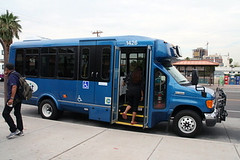Metro and DDOT to Host Public Meetings on Neighborhood Circulation Study : Residents Encouraged to Participate in Effort to Improve Transit Connecti
From email (my response at the end):
The Washington Metropolitan Area Transit Authority (WMATA) and the District Department of Transportation (DDOT) are asking residents to help enhance bus service in their neighborhoods. WMATA and DDOT are conducting a comprehensive Neighborhood Circulation Study to ensure all District neighborhoods have the proper surface transit service to support mobility and accessibility.
The DC Neighborhood Circulation Study has four primary goals:
· To identify current deficiencies in neighborhood transit connectivity.
· To improve local bus services to enhance neighborhood circulation and connectivity.
· To identify new neighborhood services that will enhance circulation and connectivity.
· To complement the long-range growth of DC’s transit system.
WMATA and DDOT understand residents are critical to the success of the study and they want to hear from you at one of the four public meetings scheduled this month.
Meeting Information:
What: Neighborhood Circulation Study Public Meeting
When: September 10, 2008, 6:30pm-8:30pm
Where: Mary’s Center, 2333 Ontario Road NW
What: Neighborhood Circulation Study Public Meeting
When: September 11, 2008, 6:30pm-8:30pm
Where: Southeast Hospital , 1310 Southern Avenue SE
What: Neighborhood Circulation Study Public Meeting
When: September 16, 2008, 6:30pm-8:30pm
Where: Trinidad Recreation Center , 1310 Childress Street NE
What: Neighborhood Circulation Study Public Meeting
When: September 17, 2008, 6:30pm-8:30pm
Where: Hughes Memorial Church , 25 53rd Street NE
-----------------------
1. I define intra-neighborhood transit, what you call "neighborhood circulation" as part of the DC tertiary transit network:
it's necessary to think of a region and the localities within the region as a transit network and set of subnetworks and plan accordingly, along these lines:
Meta (or Multi-state) Regional Transit Network: MARC and VRE service ideally combined into one multi-state compact and system, with service as far south as Norfolk and as far north as Wilmington, DE and Harrisburg, PA, and west to Charlottesville, VA (or beyond), with intermodal stations connecting to heavy and light rail transit systems; supplemented by Amtrak. This could include railroad and water-based transportation.
Washington Regional Transit Network: Regional WMATA subway system; ferry system if added; cross-jurisdictional bus rapid transit; commuter services oriented to moving people between the jurisdiction and major job centers within the region, across jurisdictional boundaries (i.e., OmniRide from Prince William County, which provides commuter-oriented service to Metro stations and job centers, with an end point in DC [and back] or the MTA Commuter buses).
Suburban Primary Transit Network: transit systems operated by Counties and Cities in the Washington region providing bus, streetcar, and lightrail service within the suburbs, and connections to stations within the regional transit network. Transit service in this category is classified by speed and destination.
Suburban Secondary Transit Network: service within cities (i.e., Falls Church , Alexandria ) and counties (PG, Montgomery, Arlington , Fairfax ) that is intra-jurisdictional.
DC Primary Transit Network: Core of the WMATA system in DC (29 stations); streetcar system; Downtown Circulator bus service; Georgetown Connector shuttle service; cross-border WMATA bus service; bus rapid/rapider transit.
DC Secondary Transit Network: the other 11 subway stations in the city; other WMATA bus service within the city; water taxi service if added, depending on the routes.
DC Tertiary Transit Network: intra-neighborhood bus services. Maybe private shuttle services (i.e., Washington Hospital Center to/from Brookland Metro, university shuttle services, etc.).
2. Here is some writing about how intra-neighborhood transit could work. Tempe, Arizona already does it.
Create intra-neighborhood transit (bus) services so that people can get to and from local services, commercial districts, schools, libraries, and to and from transit stations. This includes delivery services of "freight" such as groceries. In my transportation and land use paper, I call this "tertiary" service (based on the Arlington model of the primary and secondary transit network, see their transportation plan). And it's not like we don't have a form of this now, at least within the city. Most neighborhoods have access to some bus service, although many people may not use it because it is circutuitous or because they feel that the bus service is beneath them.
3. from a blog entry on Tempe

Venus Lee/The Arizona Republic . Hundreds of people have signed petitions, sent e-mails and made phone calls voicing opinions about if and where free shuttle service should be expanded throughout the northern half of Tempe.
In my People's Transportation Plan (in part based on a paper I wrote last May) I suggested the creation of an intra-neighborhood transit network* that could be free, and oriented to getting people to and from within a neighborhood, to transit lines and stations without having to drive, and including delivery of goods and services from local commercial districts. And I suggested this could be a free service
It turns out that Tempe Arizona has refigured part of its bus service to do exactly that.
See the Tempe In Motion (the city's Department of Transportation) website for information on the Orbit bus system as well as these articlea from the Arizona Gazette, "Neighborhood circulator buses bring sense of community" and "Venus, Mercury bus routes are in Tempe's Orbit circulation." (Note that the commenters for the later article weren't supportive.)
From the Orbit webpage:
Orbit (a FREE service) uses mini-buses to serve residential areas and connect them to local destinations such as shopping areas, other neighborhoods, major bus routes, schools and multi-generational centers. All Orbit routes run from 6 a.m. to 10 p.m. every 15 minutes, 7 days a week. "No stop zones" occur in between the crosswalks of all schools served by an Orbit route. The Orbit routes use “flag” stops, which means that the driver will pick up and drop off passengers in residential neighborhoods provided it is safe to do so.
Note that the Tempe In Motion website is another example of a best practice government agency transportation website, focused on mobility, not just transit.
Labels: neighborhood-based transportation planning, transit, transportation planning



0 Comments:
Post a Comment
<< Home